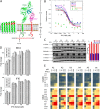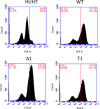Type I Interferon Signaling Is Decoupled from Specific Receptor Orientation through Lenient Requirements of the Transmembrane Domain
- PMID: 26679999
- PMCID: PMC4751381
- DOI: 10.1074/jbc.M115.686071
Type I Interferon Signaling Is Decoupled from Specific Receptor Orientation through Lenient Requirements of the Transmembrane Domain
Abstract
Type I interferons serve as the first line of defense against pathogen invasion. Binding of IFNs to its receptors, IFNAR1 and IFNAR2, is leading to activation of the IFN response. To determine whether structural perturbations observed during binding are propagated to the cytoplasmic domain, multiple mutations were introduced into the transmembrane helix and its surroundings. Insertion of one to five alanine residues near either the N or C terminus of the transmembrane domain (TMD) likely promotes a rotation of 100° and a translation of 1.5 Å per added residue. Surprisingly, the added alanines had little effect on the binding affinity of IFN to the cell surface receptors, STAT phosphorylation, or gene induction. Similarly, substitution of the juxtamembrane residues of the TMD with alanines, or replacement of the TMD of IFNAR1 with that of IFNAR2, did not affect IFN binding or activity. Finally, only the addition of 10 serine residues (but not 2 or 4) between the extracellular domain of IFNAR1 and the TMD had some effect on signaling. Bioinformatic analysis shows a correlation between high sequence conservation of TMDs of cytokine receptors and the ability to transmit structural signals. Sequence conservation near the TMD of IFNAR1 is low, suggesting limited functional importance for this region. Our results suggest that IFN binding to the extracellular domains of IFNAR1 and IFNAR2 promotes proximity between the intracellular domains and that differential signaling is a function of duration of activation and affinity of binding rather than specific conformational changes transmitted from the outside to the inside of the cell.
Keywords: cell signaling; cytokine receptor; interferon; mutagenesis; protein-protein interaction; transmembrane domain.
© 2016 by The American Society for Biochemistry and Molecular Biology, Inc.
Figures








Similar articles
-
Identification of residues of the IFNAR1 chain of the type I human interferon receptor critical for ligand binding and biological activity.Biochemistry. 2004 Oct 5;43(39):12498-512. doi: 10.1021/bi049111r. Biochemistry. 2004. PMID: 15449939
-
Localization of a receptor nonapeptide with a possible role in the binding of the type I interferons.Eur Cytokine Netw. 2000 Dec;11(4):560-73. Eur Cytokine Netw. 2000. PMID: 11125298
-
Stat2 binding to the interferon-alpha receptor 2 subunit is not required for interferon-alpha signaling.J Biol Chem. 2002 Mar 22;277(12):9713-21. doi: 10.1074/jbc.M111161200. Epub 2002 Jan 10. J Biol Chem. 2002. PMID: 11786546
-
The molecular basis for differential type I interferon signaling.J Biol Chem. 2017 May 5;292(18):7285-7294. doi: 10.1074/jbc.R116.774562. Epub 2017 Mar 13. J Biol Chem. 2017. PMID: 28289098 Free PMC article. Review.
-
The receptor of the type I interferon family.Curr Top Microbiol Immunol. 2007;316:71-95. doi: 10.1007/978-3-540-71329-6_5. Curr Top Microbiol Immunol. 2007. PMID: 17969444 Review.
Cited by
-
Kinetics of cytokine receptor trafficking determine signaling and functional selectivity.Elife. 2019 Nov 27;8:e49314. doi: 10.7554/eLife.49314. Elife. 2019. PMID: 31774398 Free PMC article.
-
The Role of Structure in the Biology of Interferon Signaling.Front Immunol. 2020 Nov 12;11:606489. doi: 10.3389/fimmu.2020.606489. eCollection 2020. Front Immunol. 2020. PMID: 33281831 Free PMC article. Review.
-
Structure-function of type I and III interferons.Curr Opin Immunol. 2024 Feb;86:102413. doi: 10.1016/j.coi.2024.102413. Epub 2024 Apr 11. Curr Opin Immunol. 2024. PMID: 38608537 Free PMC article. Review.
-
Shared and Unique Features of Human Interferon-Beta and Interferon-Alpha Subtypes.Front Immunol. 2021 Jan 19;11:605673. doi: 10.3389/fimmu.2020.605673. eCollection 2020. Front Immunol. 2021. PMID: 33542718 Free PMC article. Review.
-
Facile discovery of surrogate cytokine agonists.Cell. 2022 Apr 14;185(8):1414-1430.e19. doi: 10.1016/j.cell.2022.02.025. Epub 2022 Mar 23. Cell. 2022. PMID: 35325595 Free PMC article.
References
-
- Wilmes S., Beutel O., Li Z., Francois-Newton V., Richter C. P., Janning D., Kroll C., Hanhart P., Hötte K., You C., Uzé G., Pellegrini S., and Piehler J. (2015) Receptor dimerization dynamics as a regulatory valve for plasticity of type I interferon signaling. J. Cell Biol. 209, 579–593 - PMC - PubMed
-
- Hwang S. Y., Hertzog P. J., Holland K. A., Sumarsono S. H., Tymms M. J., Hamilton J. A., Whitty G., Bertoncello I., and Kola I. (1995) A null mutation in the gene encoding a type I interferon receptor component eliminates antiproliferative and antiviral responses to interferons α and β and alters macrophage responses. Proc. Natl. Acad. Sci. U.S.A. 92, 11284–11288 - PMC - PubMed
-
- de Weerd N. A., Vivian J. P., Nguyen T. K., Mangan N. E., Gould J. A., Braniff S. J., Zaker-Tabrizi L., Fung K. Y., Forster S. C., Beddoe T., Reid H. H., Rossjohn J., and Hertzog P. J. (2013) Structural basis of a unique interferon-β signaling axis mediated via the receptor IFNAR1. Nat. Immunol. 14, 901–907 - PubMed
Publication types
MeSH terms
Substances
Associated data
- Actions
- Actions
LinkOut - more resources
Full Text Sources

